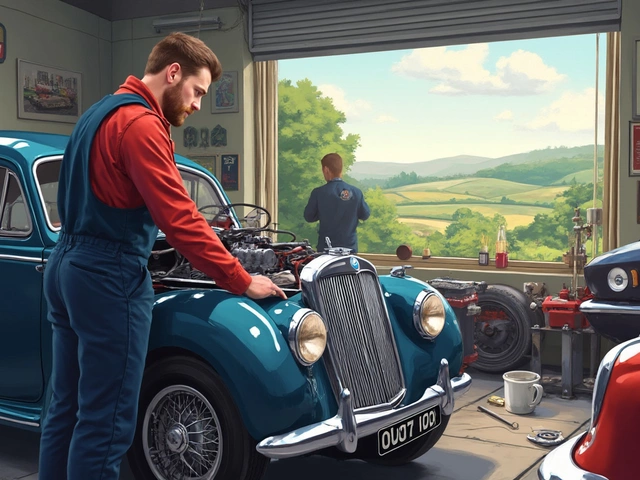Ever thought about what's happening under the hood of your car? Your engine works hard, and oil is its lifeblood. Running low on oil might not seem like a big deal at first glance, but it can lead to some pretty serious issues. So, why does it matter and what should you do about it?
Engine oil isn't just a lubricant; it's a multitasker. It cools the engine, cleans away dirt, and prevents corrosion. If your car is low on oil, you’ll likely see a warning light on your dashboard. Ignoring it is like turning a blind eye to a ticking time bomb. But what happens if you do? The engine parts get more friction, heat builds up, and before you know it, you're facing expensive repairs.
- Understanding Engine Oil
- Signs of Low Oil Levels
- Consequences of Low Oil
- Common Myths
- DIY Oil Check Tips
- When to Seek Professional Help
Understanding Engine Oil
Engine oil is one of those things you might take for granted, but it's crucial for your car. Let’s break down why it's so important. First off, engine oil is primarily a lubricant. Your engine is full of moving metal parts, and without oil, these parts would grind together, causing wear and tear that no car owner wants to deal with.
Besides lubrication, engine oil helps clean and protect the engine. It's designed to carry away dirt and debris. Think of it as the engine's own janitor, helping keep everything in working order. Plus, it coats internal parts with a layer of protection to ward off corrosion.
Cools the Engine
It's not just coolant that keeps your engine temp in check. Engine oil plays a big role in cooling your car. As it circulates, it absorbs the heat from the moving parts and keeps things from getting too toasty. Without it, your engine runs hot, which spells trouble down the road.
Enhances Efficiency
Proper levels of engine oil ensure that everything is running smoothly, which translates to better fuel efficiency. A well-lubricated engine doesn't have to work as hard, so you get more mileage out of your gas.
- Regularly checking oil levels should be a routine for every car owner.
- Choosing the right type of oil matters. Consult your owner's manual or a professional if you're unsure.
With all these roles to play, it's clear that engine oil is pretty amazing stuff. But awareness isn't enough; regular maintenance is key. Keep it topped off and stick to a car maintenance schedule, and your engine will thank you.
Signs of Low Oil Levels
Keeping your engine happy starts with spotting the early signs of low oil levels. It's not rocket science, but it needs a bit of attention. You’ll want to watch for these key indicators that your car is crying out for a top-up.
Warning Lights
Most cars have a handy little oil pressure warning light. If it flickers on, even briefly, it might be a sign your engine oil is below the recommended level. Don’t brush it off because it’s your car's way of asking for help.
Strange Noises
No, your car isn’t trying to sing. If you hear tapping or knocking sounds from the engine, it might be crying out for some lubrication. Without enough oil, the engine parts can bump and grind, leading to those odd noises.
Overheating
If your temperature gauge is pointing higher than usual, it could be because the engine isn’t getting cooled properly. Oil acts as a cooling agent, and low levels can lead to overheating.
Oil Smell Inside Car
Smelling oil inside your car isn’t normal. It could mean a leak or burning oil. Either way, it’s a red flag for low oil and something you should check out ASAP.
Performance Drop
Notice your car isn’t accelerating like it used to? A sluggish performance can be linked to low engine oil because parts aren’t working smoothly without proper lubrication.
Regular Dipstick Check
Want to be sure? Pop the hood and take a look at the oil dipstick. If it shows a low reading, it's time for an oil change or refill. Here’s how to do it in three steps:
- Park the car on a flat surface and turn off the engine.
- Remove the dipstick, wipe it clean, then insert it back fully.
- Pull it out again to see where the oil level hits between the 'Min' and 'Max' marks.
Stay on top of car maintenance by checking these signs regularly. It’s much easier than dealing with the headaches that come from overlooking them!
Consequences of Low Oil
Letting your car get low on engine oil is like running a marathon without water—eventually, things will go south. The biggie here is that low oil levels can seriously mess with your engine.
Increased Friction
Oil is the barrier between metal parts that keep them from grinding against each other. When you’re low, they rub like sandpaper, which can cause wear and tear. Over time, this can lead to parts breaking down, which isn't cheap to fix.
Heat Buildup
Your car's engine gets hot, and oil helps cool it down. Low oil means less cooling, and your engine parts can overheat. Overheating leads to engine seizing—a fancy term for 'dead engine,' and happens surprisingly often to people who skip oil checks.
Engine Damage
If you run out of oil entirely, you're looking at engine parts welding themselves together. It's called 'engine lockdown' and it's as bad as it sounds. You'll either face a hefty repair bill or need a new car.
Corrosion
Oil also prevents rust and corrosion by keeping moisture away. Less oil means more moisture, leading to rust taking over engine components. Rusted parts might mean your car will start aging before its time.
| Issue | Potential Cost |
|---|---|
| Engine Overhaul | £2,500-£4,000 |
| Engine Replacement | £3,000-£5,500 |
Having enough oil in your engine is crucial—not just for smooth driving, but to avoid painful repairs and extra costs.

Common Myths
There's a lot of misinformation out there about engine oil and what happens when your car is low on it. Let's clear up some of the common myths so you can make sure you're taking the best care of your vehicle.
Myth #1: All Oil Is the Same
It's a popular belief that as long as the oil is slick, it'll do the trick. Not true! Different engines require different types of oil. Using the wrong type can affect performance and might not protect your engine properly. Check your owner's manual for the recommended oil type for your car.
Myth #2: Older Cars Use More Oil
While it's true that some wear and tear can cause cars to consume more oil, it's not a given for all older vehicles. Regular maintenance and using the right oil can keep consumption in check. If you're adding oil too often, it might be time to check for leaks or other issues.
Myth #3: If the Oil Light Isn't On, You're Good
Some folks think that as long as the oil warning light hasn't come on, there's no need to check oil levels. But here's the thing: By the time that light comes up, you're already at risk of damaging your engine. Regularly checking your oil levels manually is a small step that can save you a lot down the road.
Myth #4: Oil Never Goes Bad
There's a misconception that engine oil can last forever. While it's true that oil doesn't 'expire' like food, it does lose its effectiveness over time and with use. Contaminants build up, and the oil breaks down, making regular oil changes crucial for engine health.
Understanding these myths can help you avoid costly car maintenance mistakes. Keeping informed ensures your vehicle runs smoothly and can extend its lifespan significantly.
DIY Oil Check Tips
Checking your engine oil is like giving your car a quick health checkup. You don't need to be a mechanic to do it, and it's easier than you might think. Here's how to make sure your car maintenance routine includes this crucial step.
Gather Your Tools
First, make sure you've got what you need: a clean cloth or paper towel, and obviously the car. That's pretty much it!
Instructions to Check Oil Levels
- Park on Level Ground: Ensure your car is parked on a flat surface and, for best results, wait until the engine is cold or has been off for at least five minutes.
- Locate the Dipstick: Pop your car's hood and look for the oil dipstick – it's usually got a bright handle, often yellow or orange.
- Pull and Clean: Pull out the dipstick, wipe it clean with your cloth or paper towel to remove any oil residue.
- Dip and Check: Reinsert the dipstick all the way back, wait a couple of seconds, then pull it out again.
- Read the Level: Check the oil level against the markings on the dipstick. There are usually two marks indicating 'low' and 'full'. Your oil should fall between these two marks.
Regular Checks
Make it a habit to check your oil at least once a month. If you often drive long distances, consider doing it more frequently.
Top Off If Needed
If your oil levels are low, you should top it up. Always keep a bottle of your vehicle's recommended oil type in your trunk.
Useful Data
If you find yourself constantly adding oil, it might indicate a leak, and you might need professional help. Don't ignore this, as it could lead to serious damage.
| Recommended Check Frequency | Vehicle Type |
|---|---|
| Monthly | Cars, SUVs, Trucks |
These steps should help you keep your engine oil in check and ensure smooth car maintenance. It's straightforward, and doing this regularly can save a lot of headache and money in the long run.
When to Seek Professional Help
Sometimes checking your engine oil might reveal problems beyond your basic DIY skills. It's crucial to know when it's time to call in a pro. After all, catching issues early can save you from shelling out big bucks down the line.
Strange Sounds?
If your car is making weird noises, think of it as its way of crying out for help. Knocking or ticking sounds often mean your engine parts aren't getting the lubrication they need. This is a good hint to visit a mechanic.
Warning Lights and Strange Smells
The moment you see that oil warning light, don't ignore it. Combine that with a burnt oil smell, and things might be heating up too much under the hood. A mechanic can diagnose and fix these issues before they cascade into something bigger.
Oil Leaks
Seeing oil spots under your car? It's more than just an eyesore. Leaks mean you're losing oil quicker than usual, and this could spell trouble for your engine. Professional help can identify the source and fix it properly.
Here's a tip: always follow your manufacturer's maintenance schedule found in your car's manual. It's a roadmap for when professional help is needed, even if things seem fine. A regular check can also reveal hidden problems before they become visible headaches.
| Sign | Potential Issue |
|---|---|
| Strange Noises | Engine parts rubbing |
| Warning Light | Low oil pressure |
| Oil Leaks | Seal or gasket failure |
| Burnt Oil Smell | Overheating engine |
Ignoring these low oil effects and signs will only exacerbate the problem. So, when your car throws you a hint, listen! A trip to the mechanic might seem like a hassle, but it's always better than being stranded on the side of the road.






